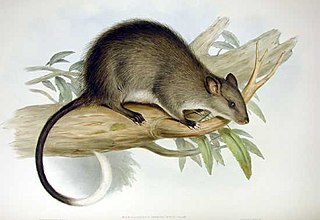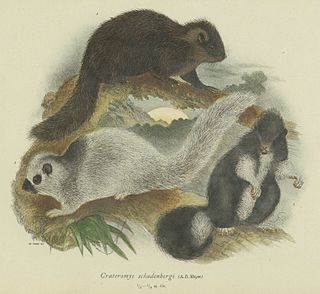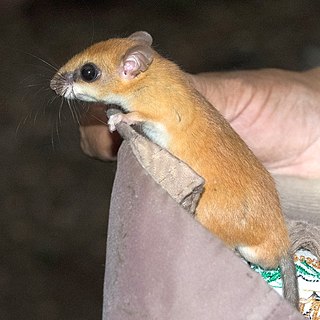
The white-nosed coati, also known as the coatimundi, is a species of coati and a member of the family Procyonidae. Local Spanish names for the species include antoon, gato solo, pizote, and tejón, depending upon the region. It weighs about 4–6 kg (8.8–13.2 lb), and the nose-to-tail length of the species is about 110 cm (3.6 ft) with about half of that being the tail length. However, small females can weigh as little as 3.1 kg (6.8 lb), while large males can weigh as much as 9 kg (20 lb).

The brush-tailed phascogale, also known by its Australian native name tuan, the common wambenger, the black-tailed mousesack or the black-tailed phascogale, is a rat-sized arboreal carnivorous marsupial of the family Dasyuridae, characterized by a tuft of black silky hairs on the terminal portion of its tail. Males of this species do not live past the age of one, as they die after reproducing.

The zone-tailed hawk is a medium-sized hawk of warm, dry parts of the Americas. It is somewhat similar in plumage and flight style to a common scavenger, the turkey vulture, and may benefit from being able to blend into groups of vultures. It feeds on small terrestrial tetrapods of all kinds.

The Indian giant squirrel or Malabar giant squirrel is a large multi-coloured tree squirrel species endemic to forests and woodlands in India. It is a diurnal, arboreal, and mainly herbivorous squirrel.

The brown palm civet, also called the Jerdon's palm civet, is a viverrid endemic to the Western Ghats of India.

The black-footed tree-rat, also known as Djintamoonga, is one of two endemic Australian rodent species in the genus Mesembriomys. Both the black-footed tree-rat and its congener, the golden-backed tree-rat, are found in northern Australia. The species is one of the largest murids found in Australia.

Tome's spiny rat, also known as Tomes' spiny rat or the Central American spiny rat, is a species of spiny rat distributed from Honduras to Ecuador. The IUCN has assessed its conservation status as being of "least concern".

Sumichrast's vesper rat is a rodent of the family Cricetidae found from southern Mexico to Panama. It is named for François Sumichrast, the collector of the first specimen, and its closest relative is probably Hatt's vesper rat, a similar, but slightly smaller, species from the Yucatán Peninsula.

The giant bushy-tailed cloud rat or Luzon bushy-tailed cloud rat is a large, endangered species of rodent in the family Muridae. It is only found in pine and mossy forest at altitudes of 2,000–2,740 metres (6,560–8,990 ft) in the Central Cordillera of Luzon, the Philippines. Relatively little is known about its behavior, but it is nocturnal, mainly arboreal and feeds on various types of vegetation.
The montane hylomyscus or montane wood mouse is a species of rodent in the family Muridae. A long-coated species with brownish-grey upper parts and whitish-grey underparts, it occurs in the uplands of tropical Central Africa where its natural habitat is tropical moist montane forests.
The Ethiopian forest brush-furred rat or golden-footed brush-furred rat, is a species of rodent in the family Muridae. It is endemic to Ethiopia where its natural habitat is subtropical or tropical moist montane forests. It is threatened by habitat loss.

The golden-backed tree rat is a species of rodent in the family Muridae, found only in Australia.
Nelson's woodrat is a species of rodent in the family Cricetidae. It is endemic to Mexico, where it is known only from the eastern slopes of the volcanoes Orizaba and Cofre de Perote. Due to the small geographic range, isolation, and low population, the Nelson's woodrat has a higher risk for extinction. The distribution and population sizes are small. The population exists in geographic isolation, which prevents gene flow

Hatt's vesper rat, also known as Hatt's vesper mouse or Yucatán vesper rat, is a species of rodent in the family Cricetidae. It is the only species in the genus Otonyctomys. It is named for its discoverer, Robert T. Hatt.
The tawny deer mouse or marsh mouse is a species of rodent in the family Cricetidae. It is found only in Mexico.

The black-tailed tree rat, also called black-tailed acacia rat or black-tailed thallomys,, is a species of rodent in the family Muridae. It is found in Angola, Botswana, Namibia and South Africa, where its natural habitat is subtropical or tropical dry shrubland. It is both nocturnal and arboreal and makes bulky nests in the trees, often acacias, where it feeds on leaves and buds.
The giant naked-tailed rat is a species of rodent in the family Muridae. It is found in West Papua, Indonesia and Papua New Guinea. It lives in tropical forests, wetlands, and in degraded forests.

The grayish or gray mouse opossum is a diminutive species of opossum in the family Didelphidae, endemic to Mexico. It is the sole species of its monotypic genus, Tlacuatzin.

Nelson's kangaroo rat is a species of rodent in the family Heteromyidae which is endemic to the central plateau of Mexico.

The short-tailed hawk is an American bird of prey in the family Accipitridae, which also includes the eagles and Old World vultures. As a member of the genus Buteo, it is not a true hawk and thus also referred to as a "buteo" or "buzzard". The white-throated hawk is a close relative and was formerly included in the species B. brachyurus.
















